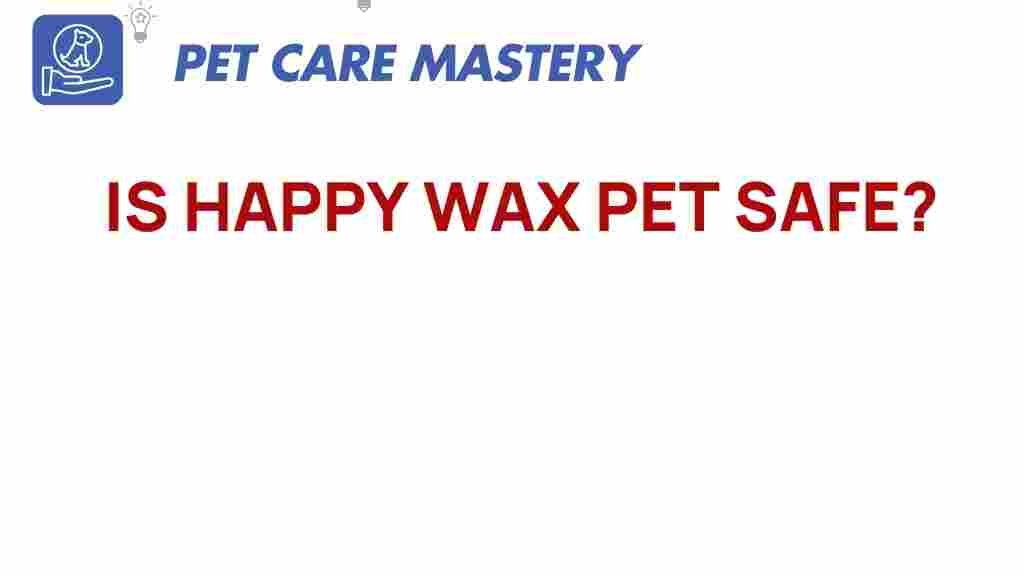Is Happy Wax Pet Safe? Unraveling the Truth Behind Scented Wax
In the world of home fragrance, Happy Wax has carved out a niche for itself with its delightful scents and charming designs. However, pet owners often find themselves asking the question: Is Happy Wax pet safe? As much as we adore our furry companions, their safety is paramount when it comes to household products. This article will explore the safety of using Happy Wax around pets, shedding light on ingredients, potential risks, and tips for responsible use.
Understanding Happy Wax
Before diving into the specifics of safety, it’s essential to understand what Happy Wax is. Happy Wax produces scented wax melts that are designed to be used in wax warmers. Unlike traditional candles, these melts do not have a wick and are melted to release fragrance into the air.
- Variety of Scents: Happy Wax offers a wide range of aromas, from fruity to floral to seasonal scents.
- Eco-Friendly: Many users appreciate that Happy Wax is made from natural soy wax, making it a more eco-friendly option compared to paraffin wax.
- Kid-Friendly: The brand markets its products as safe for households with children.
Ingredients of Happy Wax
When assessing whether Happy Wax is safe for pets, the first step is to look at its ingredients. Most Happy Wax products are made from:
- Soy Wax: A natural wax derived from soybeans, generally considered safe for both humans and pets.
- Fragrance Oils: These can be synthetic or natural. The safety of these oils largely depends on their composition.
- Colorants: Used for aesthetic purposes, these are typically safe but should be checked for specific pet safety information.
While the main components of Happy Wax are generally safe, some fragrance oils can be harmful to pets if inhaled or ingested. It’s crucial to be mindful of the specific scents you choose.
Assessing Pet Safety
Now that we understand the composition of Happy Wax, let’s delve deeper into whether it is safe for pets. Here are some key considerations:
- Essential Oils: Many scented products contain essential oils, which can be toxic to pets, particularly cats. Always check whether the specific fragrance contains essential oils.
- Ingestion Risks: If your pet is prone to chewing or eating non-food items, there is a risk of ingestion. Ensure that wax melts are kept out of reach.
- Respiratory Issues: Pets with pre-existing respiratory conditions may be more sensitive to strong fragrances. Start with a small amount and observe your pet’s reaction.
How to Use Happy Wax Safely Around Pets
If you’re a pet owner who enjoys using Happy Wax, there are several steps you can take to ensure your furry friend’s safety:
Step 1: Choose Pet-Friendly Scents
Stick to scents that are known to be safe for pets. Some fragrances, such as lavender and chamomile, are typically considered safe, but always verify with your veterinarian.
Step 2: Ventilation is Key
Always use Happy Wax in a well-ventilated area. This helps disperse the fragrance and minimizes any potential respiratory irritants.
Step 3: Supervise Your Pets
When using Happy Wax, supervise your pets. This ensures they don’t get too close to the warmer or accidentally ingest any wax.
Step 4: Store Properly
Keep your wax melts in a sealed container and out of reach of pets. This will help prevent accidental ingestion.
Step 5: Monitor Behavior
After using Happy Wax, watch your pets for any unusual behavior. If you notice signs of distress, such as coughing or lethargy, discontinue use immediately.
Troubleshooting Common Issues
Even with precautions, you may encounter some issues while using Happy Wax around pets. Here are some troubleshooting tips:
- Pet Sneezing or Coughing: If your pet starts sneezing or coughing, turn off the warmer and ventilate the area. This could indicate they are sensitive to the fragrance.
- Wax Ingestion: If you suspect your pet has ingested wax, contact your veterinarian immediately. While soy wax is generally not toxic, it can still cause gastrointestinal upset.
- Behavioral Changes: Any changes in your pet’s behavior, such as increased anxiety or lethargy, should be monitored closely. If symptoms persist, consult with a veterinarian.
Consulting Your Veterinarian
When in doubt, it’s always a good idea to consult your veterinarian. They can provide personalized advice based on your pet’s health history and any specific concerns you may have regarding Happy Wax or other scented products.
Alternatives to Happy Wax
If you find that Happy Wax may not be the best fit for your household, consider these alternatives that are often regarded as safer for pets:
- Essential Oil Diffusers: Use pet-safe essential oils in a diffuser, ensuring the space is well-ventilated.
- Natural Candles: Opt for candles made from beeswax or soy with no added fragrances.
- Air Purifiers: Consider using an air purifier to help eliminate odors without the use of scented products.
Conclusion
So, is Happy Wax pet safe? The answer is nuanced. While the ingredients used in Happy Wax are generally safe, certain fragrances may pose risks to pets, particularly those with sensitivities or pre-existing conditions. By following the safety tips outlined in this article, pet owners can enjoy the delightful scents of Happy Wax while ensuring their furry friends remain safe and comfortable.
If you’re looking for more information on pet safety and home products, check out this resource on pet-friendly home fragrances. And as always, for any specific concerns regarding your pet’s health, consult your veterinarian.
This article is in the category Products and created by PetCareMastery Team
